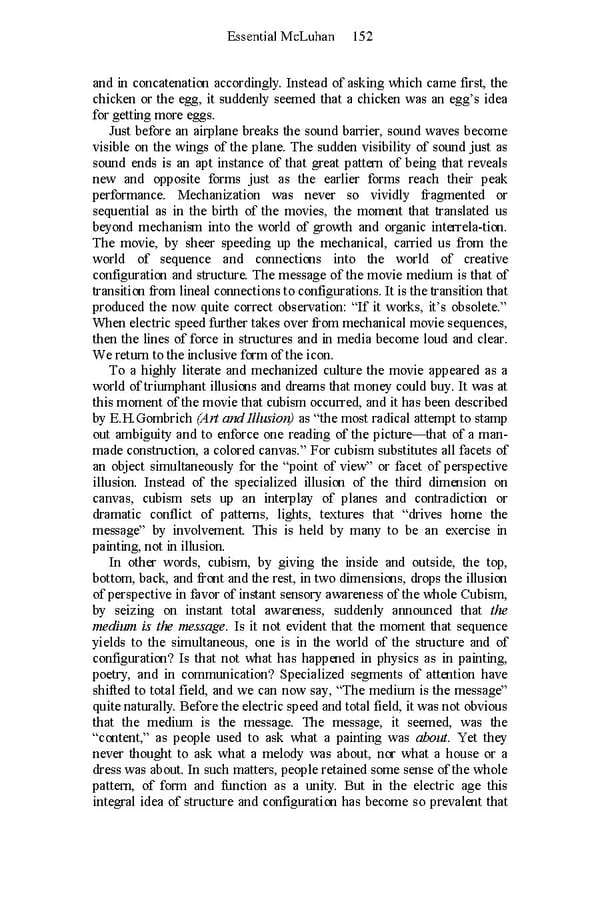Essential McLuhan 152 and in concatenation accordingly. Instead of asking which came first, the chicken or the egg, it suddenly seemed that a chicken was an egg’s idea for getting more eggs. Just before an airplane breaks the sound barrier, sound waves become visible on the wings of the plane. The sudden visibility of sound just as sound ends is an apt instance of that great pattern of being that reveals new and opposite forms just as the earlier forms reach their peak performance. Mechanization was never so vividly fragmented or sequential as in the birth of the movies, the moment that translated us beyond mechanism into the world of growth and organic interrela-tion. The movie, by sheer speeding up the mechanical, carried us from the world of sequence and connections into the world of creative configuration and structure. The message of the movie medium is that of transition from lineal connections to configurations. It is the transition that produced the now quite correct observation: “If it works, it’s obsolete.” When electric speed further takes over from mechanical movie sequences, then the lines of force in structures and in media become loud and clear. We return to the inclusive form of the icon. To a highly literate and mechanized culture the movie appeared as a world of triumphant illusions and dreams that money could buy. It was at this moment of the movie that cubism occurred, and it has been described by E.H.Gombrich (Art and Illusion) as “the most radical attempt to stamp out ambiguity and to enforce one reading of the picture—that of a man- made construction, a colored canvas.” For cubism substitutes all facets of an object simultaneously for the “point of view” or facet of perspective illusion. Instead of the specialized illusion of the third dimension on canvas, cubism sets up an interplay of planes and contradiction or dramatic conflict of patterns, lights, textures that “drives home the message” by involvement. This is held by many to be an exercise in painting, not in illusion. In other words, cubism, by giving the inside and outside, the top, bottom, back, and front and the rest, in two dimensions, drops the illusion of perspective in favor of instant sensory awareness of the whole Cubism, by seizing on instant total awareness, suddenly announced that the medium is the message. Is it not evident that the moment that sequence yields to the simultaneous, one is in the world of the structure and of configuration? Is that not what has happened in physics as in painting, poetry, and in communication? Specialized segments of attention have shifted to total field, and we can now say, “The medium is the message” quite naturally. Before the electric speed and total field, it was not obvious that the medium is the message. The message, it seemed, was the “content,” as people used to ask what a painting was about. Yet they never thought to ask what a melody was about, nor what a house or a dress was about. In such matters, people retained some sense of the whole pattern, of form and function as a unity. But in the electric age this integral idea of structure and configuration has become so prevalent that
 Essential McLuhan Page 158 Page 160
Essential McLuhan Page 158 Page 160